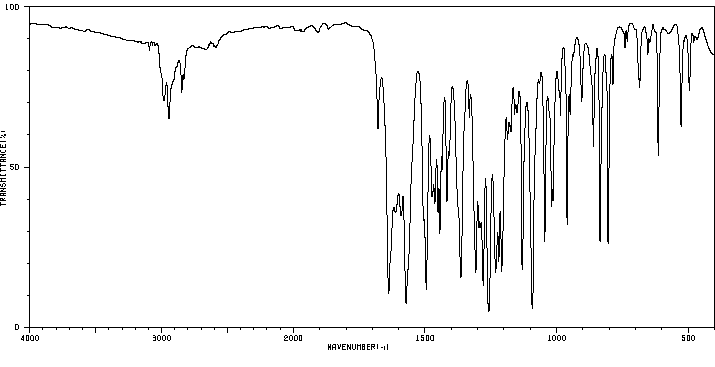(E)-1-(2-hydroxy-4-methoxyphenyl)-3-(2,3,4-trimethoxyphenyl)prop-2-en-1-one | 36685-61-7
分子结构分类
中文名称
——
中文别名
——
英文名称
(E)-1-(2-hydroxy-4-methoxyphenyl)-3-(2,3,4-trimethoxyphenyl)prop-2-en-1-one
英文别名
1-(2-hydroxy-4-methoxyphenyl)-3-(2,3,4-trimethoxyphenyl)prop-2-en-1-one;(E)-2'-hydroxy-2,3,4,4'-tetramethoxychalcone;2'-hydroxy-2,3,4,4'-tetramethoxychalcone
CAS
36685-61-7
化学式
C19H20O6
mdl
——
分子量
344.364
InChiKey
DOMQQVLOFWGMFV-WEVVVXLNSA-N
BEILSTEIN
——
EINECS
——
-
物化性质
-
计算性质
-
ADMET
-
安全信息
-
SDS
-
制备方法与用途
-
上下游信息
-
文献信息
-
表征谱图
-
同类化合物
-
相关功能分类
-
相关结构分类
计算性质
-
辛醇/水分配系数(LogP):3.8
-
重原子数:25
-
可旋转键数:7
-
环数:2.0
-
sp3杂化的碳原子比例:0.21
-
拓扑面积:74.2
-
氢给体数:1
-
氢受体数:6
SDS
上下游信息
-
上游原料
中文名称 英文名称 CAS号 化学式 分子量 2,3,4-三甲氧基苯甲醛 2,3,4-trimethoxybenzaldehyde 2103-57-3 C10H12O4 196.203
反应信息
-
作为反应物:描述:(E)-1-(2-hydroxy-4-methoxyphenyl)-3-(2,3,4-trimethoxyphenyl)prop-2-en-1-one 在 硫酸 作用下, 以 甲醇 为溶剂, 反应 7.0h, 以52%的产率得到7,2',3',4'-tetramethoxyflavanone参考文献:名称:摘要:Purpose. Aromatase inhibitors are known to prevent the conversion of androgens to estrogens and play a significant role in the treatment of estrogen dependent diseases such as breast cancer. Some flavonoids have been reported as potent aromatase inhibitors: therefore. in an effort to develop novel anti breast cancer agents. B ring substituted flavanones with a 7-methoxy group on A ring were synthesized and tested to assess their ability to inhibit aromatase activity and to determine the optimal B ring substitution pattern.Methods. A series of flavanones was prepared by cyclisation of 2'-hydroxychalcones previously obtained by Claisen-Schmidt condensation and the aromatase inhibitory activity or these compounds was investigated using human placental microsomes and radiolabeled [1.2,6,7-H-3]-androstenedione as substrate.Results. Almost all flavanones exhibited inhibitory effect on the aromatase activity but their potency was dependent on their B ring subtitution pattern. Hydroxylation at position 3' and/or 4' enhanced the anti-aromatase activity thus, 3'.4'-dihydroxy-7-methoxyflavanone was found to he twice more potent than aminoglutethimide. the first aromatase inhibitor clinically used.Conclusions. These results indicated that these flavanones could be considered as potential anti breast cancer agents through the inhibition of aromatase activity and allowed us to select some of these Compounds as skeleton for the development of flavonoid structurally-related aromatase inhibitors.DOI:10.1023/a:1014490817731
-
作为产物:描述:丹皮酚 、 2,3,4-三甲氧基苯甲醛 在 potassium hydroxide 作用下, 以 乙醇 为溶剂, 反应 73.0h, 以59%的产率得到(E)-1-(2-hydroxy-4-methoxyphenyl)-3-(2,3,4-trimethoxyphenyl)prop-2-en-1-one参考文献:名称:结构多样的双黄酮类化合物的合成摘要:合成的双黄酮类化合物与有趣的生物学活性有关,但在药物发现中仍缺乏很好的探索。近年来,目睹了对合成方法的日益增长的兴趣,这些方法可以提供结构新颖的双黄酮类化合物,因此可以更充分地研究此类化合物的生物学用途。在本文中,我们报告了基于铃木-宫浦交叉偶联和醇甲基化的策略,用于合成两类双黄酮类化合物:(i)含有属于不同亚类的类黄酮单体的稀有“杂化”衍生物,以及(ii)同二聚体化合物,其中两个类黄酮单体通过亚甲二氧基连接。DOI:10.1016/j.tet.2018.05.003
文献信息
-
Novel Chalcone Derivatives With Antimitotic Activity申请人:Boumendjel Ahcene公开号:US20090182058A1公开(公告)日:2009-07-16The present invention relates to novel chalcone derivatives of formula (I): wherein X, Y, Z, W, RI, R2, R3, R4 and R5 are as defined, said derivatives having antimitotic activity, as well as to pharmaceutical compositions containing such compounds and to their use for making drugs.本发明涉及具有抗有丝分裂活性的新型葵花素衍生物的公式(I):其中X、Y、Z、W、RI、R2、R3、R4和R5如定义所述,以及含有这种化合物的药物组合物,以及其用于制备药物的用途。
-
Synthesis and biological evaluation of chalcone, dihydrochalcone, and 1,3-diarylpropane analogs as anti-inflammatory agents作者:Mopur Vijaya Bhaskar Reddy、Hsin-Yi Hung、Ping-Chung Kuo、Guan-Jhong Huang、Yu-Yi Chan、Shiow-Chyn Huang、Shwu-Jen Wu、Susan L. Morris-Natschke、Kuo-Hsiung Lee、Tian-Shung WuDOI:10.1016/j.bmcl.2017.02.038日期:2017.4Twenty-one chalcones were prepared via aldol condensation and subsequent reduction of these compound led to the corresponding dihydrochalcone and 1,3-diphenylpropane derivatives. The synthetic products were examined for their effects on NO inhibition in LPS-activated mouse peritoneal macrophages. Among the tested compounds, a 1,3-diarylpropane analog, 2-(3-(3,4-dimethoxyphenyl)propyl)-5-methoxyphenol
-
Antimitotic and Antiproliferative Activities of Chalcones: Forward Structure–Activity Relationship作者:Ahcène Boumendjel、Julien Boccard、Pierre-Alain Carrupt、Edwige Nicolle、Madeleine Blanc、Annabelle Geze、Luc Choisnard、Denis Wouessidjewe、Eva-Laure Matera、Charles DumontetDOI:10.1021/jm0708331日期:2008.4.1A series of 59 chalcones was prepared and evaluated for the antimitotic effect against K562 leukemia cells. The most active chalcones were evaluated for their antiproliferative activity against a panel of I I human and murine cell cancer lines. We found that three chalcones were of great interest as potential antimitotic drugs. In vivo safety studies conducted on one of the most active chalcones revealed that the compound was safe, allowing further in vivo antitumor evaluation.
-
1-(2-Hydroxy-4-methoxyphenyl)-3-(2,3,4-trimethoxyphenyl)prop-2-en-1-one作者:A. Subbiah Pandi、D. Velmurugan、S. Shanmuga Sundara Raj、Hoong-Kun Fun、M. C. BansalDOI:10.1107/s0108270103008679日期:2003.6.15The title compound, C19H20O6, crystallizes in the centrosymmetric space group P2(1)/c with one molecule in the asymmetric unit. The molecule is approximately planar and the dihedral angle between the phenyl rings is 11.0(1)degrees. The H atoms of the central propenone group are trans. There is an intramolecular O-H...O hydrogen bond and the molecules are crosslinked by four intermolecular C-H...O hydrogen bonds, producing a three-dimensional network.
-
ASHIHARA Y.; NAGATA Y.; KUROSAWA K., BULL. CHEM. SOC. JAP. <BCSJ-A8>, 1977, 50, NO 12, 3298-3301作者:ASHIHARA Y.、 NAGATA Y.、 KUROSAWA K.DOI:——日期:——
表征谱图
-
氢谱1HNMR
-
质谱MS
-
碳谱13CNMR
-
红外IR
-
拉曼Raman
-
峰位数据
-
峰位匹配
-
表征信息
同类化合物
(2Z)-1,3-二苯基-2-丙烯-1-酮,2-丙烯-1-酮,1,3-二苯基-,(2Z)-
龙血素D
龙血素A
龙血素 B
黄色当归醇F
黄色当归醇B
黄腐醇; 黄腐酚
黄腐醇 D; 黄腐酚 D
黄腐酚B
黄腐酚
黄腐酚
黄卡瓦胡椒素 C
高紫柳查尔酮
阿普非农
阿司巴汀
阿伏苯宗
金鸡菊查耳酮
邻肉桂酰苯甲酸
达泊西汀杂质25
豆蔻明
补骨脂色烯查耳酮
补骨脂查耳酮
补骨脂呋喃查耳酮
补骨脂乙素
蜡菊亭; 4,2',4'-三羟基-6'-甲氧基查耳酮
苯酚,4-[3-(2-羟基苯基)-1-苯基丙基]-2-(3-苯基丙基)-
苯磺酰胺,N-[4-[3-(3-羟基苯基)-1-羰基-2-丙烯基]苯基]-
苯磺酰胺,N-[3-[3-(4-羟基-3-甲氧苯基)-1-羰基-2-丙烯基]苯基]-
苯磺酰胺,4-甲氧基-N,N-二甲基-2-(3-羰基-3-苯基-1-丙烯基)-,(E)-
苯磺酰氯化,4,5-二甲氧基-2-(3-羰基-3-苯基-1-丙烯基)-,(E)-
苯磺酰氯,4-甲氧基-3-(3-羰基-3-苯基-1-丙烯基)-,(E)-
苯甲醇,4-甲氧基-a-[2-(4-甲氧苯基)乙烯基]-
苯甲酸-[4-(3-氧代-3-苯基-丙烯基)-苯胺]
苯甲酸,3-[3-(4-溴苯基)-1-羰基-2-丙烯基]-4-羟基-
苯甲酰(2-羟基苯酰)甲烷
苯甲腈,4-(1-羟基-3-羰基-3-苯基丙基)-
苯基[2-(1-萘基)乙烯基]甲酮
苯基-(三苯基-丙-2-炔基)-醚
苯基-(2-苯基-2,3-二氢-苯并噻唑-2-基)-甲酮
苯亚甲基苯乙酮
苯乙酰腈,a-(1-氨基-2-苯基亚乙基)-
苯丙酸,a-苯甲酰-b-羰基-,苯基(苯基亚甲基)酰肼
苯,1-(2,2-二甲基-3-苯基丙基)-2-甲基-
苏木查耳酮
苄桂哌酯
苄基(4-氯-2-(3-氧代-1,3-二苯基丙基)苯基)氨基甲酸酯
芦荟提取物
腈苯唑
胀果甘草宁C
聚磷酸根皮酚







